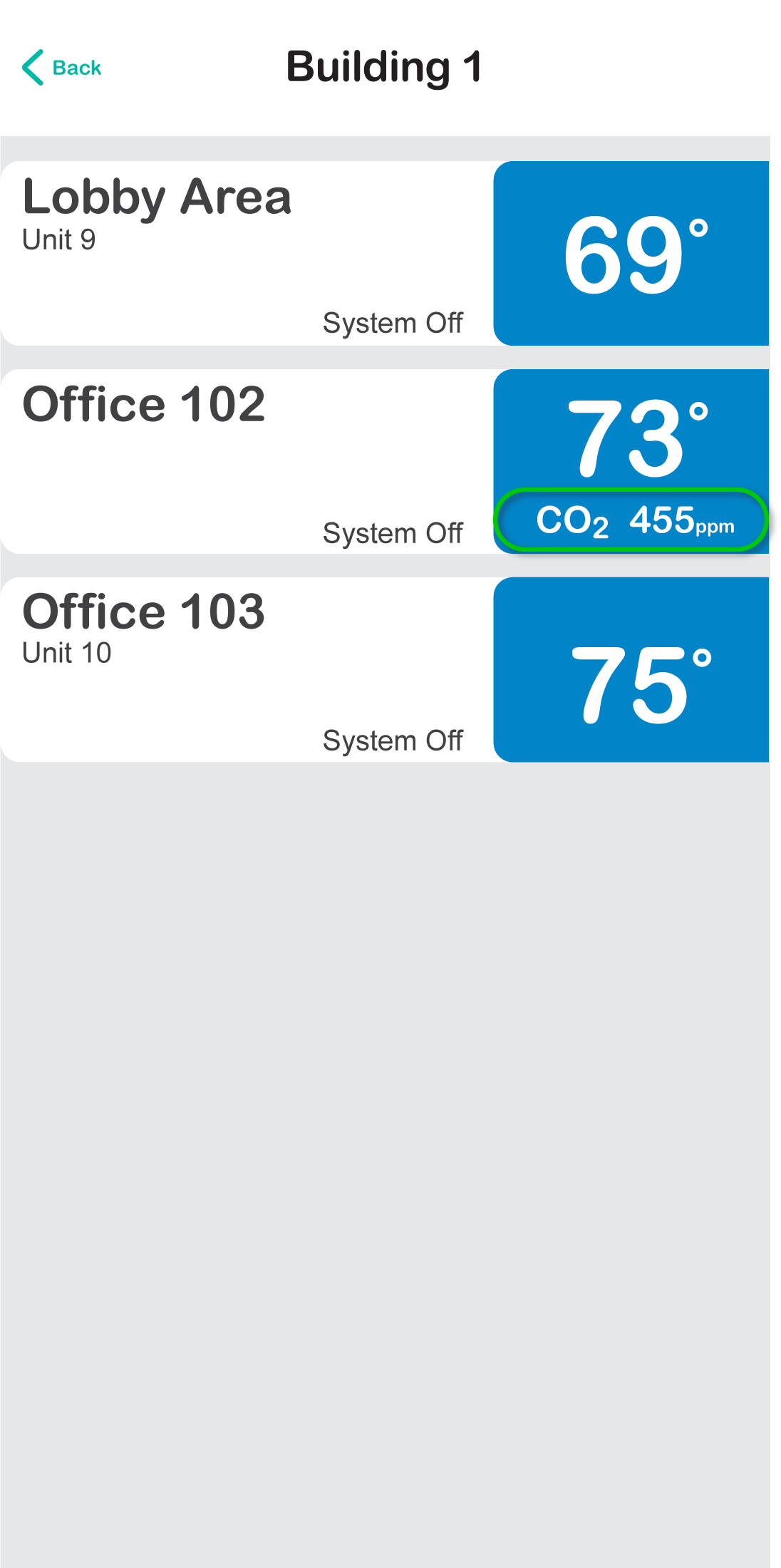Where do I find room CO2 Levels?
In small text under a room’s temperature, areas in your building which have a Pelican CO2 sensor will display the real-time CO2 concentration levels, in parts-per-million (ppm), for that area.

Where are Pelican CO2 sensors located?
A Pelican CO2 sensor is integrated into a Pelican thermostat. So, it is in the ideal location for proper relative humidity readings, if it is also in the ideal location for proper temperature detection.
What is CO2?
CO2 is a colorless, odorless gas produced by respiration; a gas humans breath out. The detection of CO2 by your Pelican solution is to let the Pelican solution know when the space is occupied and how many people are in the space. Higher CO2 = more people in the space. Depending on what Pelican equipment is installed at your site, Pelican will adjust the ventilation rate (how much outside air is being brought into the space) in relation to these CO2 readings. High CO2 = more people = more ventilation.
What is ppm?
Parts per million (ppm) is the number of units of a particle per million units of total particles.
What do different CO2 levels indicate ?
Because CO2 is a gas humans breath out, measuring a room’s CO2 concentration levels is an effective way to know when a room is occupied and how occupied that room is.
Is this detected for Life Safety?
No. This is not a life-safety indication and should not be used as one.
Adjusting CO2 Thresholds
Because the thermostat’s CO2 Threshold is used to provide proper ventilation to a room, this is not a general setting on your Pelican solution. Instead, this is a configured setting, which will be found under the Admin and Thermostat Configuration sections.
1. On your Pelican App, select Admin either at the bottom of the app or in the upper right hand corner.
2. Select Thermostat Configuration and find the thermostat you want to adjust the CO2 Threshold for.
3. Under that thermostat’s configuration screen, scroll to the section labeled Temperature Settings and look for CO2 Ventilation.
4. The default CO2 Threshold is 800ppm. In the box to the right of CO2 Ventilation you can adjust the CO2 threshold setting between 400ppm and 2000ppm.
5. Once set, hit the back button in the upper left hand corner of your app and the new CO2 threshold setting will be pushed to that room’s thermostat.
Why is Pelican’s default CO2 Threshold set to 800ppm?
Most ventilation codes and/or professional organizations (such as ASHRAE – American Society of Heating, Refrigerating and Air-Conditioning Engineers) recommend rooms be at their maximum required ventilation rates when CO2 levels reach 1000 ppm (or 600 ppm above outside CO2 concentration levels, where outside CO2 concentration is assumed to be 400ppm). During occupied hours, anytime a room is below 1000 ppm, the room can be at a reduce ventilation rate ( which is determined by local code). Setting your Pelican CO2 threshold to 800 ppm tells the thermostat to begin increasing the room’s ventilation rate beyond the minimum ventilation rate when CO2 levels reach 800 ppm. We call this Ventilation Anticipation. Our theory is by beginning to ventilate before reaching 1000 ppm, we are increasing the ventilation rates in proportion to how occupied the room is, instead of dramatically increasing and decreasing ventilation rates on a fixed 1000 ppm. We have found that this anticipation algorithm provides better ventilation, creates a safer indoor environment, and is more energy efficient than two-position (minimum and maximum) control systems.
Pelican’s default CO2 threshold setting of 800 ppm is just our recommendation in an attempt to generate proper ventilation rates and a safer indoor environment. Most codes allow you to adjust this CO2 threshold to 1000ppm. Please check your local codes and your other ventilation settings in your Pelican solution to make sure you are providing proper ventilation.
